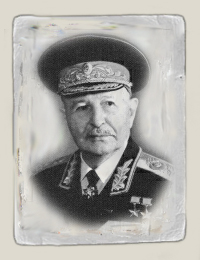Ivan Bagramyan
 2.12.1897 - 21.9.1982 2.12.1897 - 21.9.1982Ivan Bagramyan was a commander of the 1st Baltic Front, Army General. He was born on December 2, 1897 in Yelizavetpol (today the city of Gendje, Azerbaijan). Armenian. A member of the CPSU (B) / Communist Party from 1941. Joined the Red Army / Soviet Army in 1920. In 1925, he graduated from the courses of advanced training commanders of the cavalry, in 1931 - postgraduate courses of higher command personnel, in 1934 - the Frunze Military Academy, in 1938 - the General Staff Military Academy. In 1915 he was drafted into the army and sent to the warrant officers’ school, which he graduated in 1917. Participated in the First World War. During the Civil War fought for the establishment of the Soviet power in Armenia and Georgia. In 1923-31 he commanded a cavalry regiment of the Armenian Infantry Division. In 1934-36 he was Chief of Staff of the Cavalry Division. Since 1938 - Senior Lecturer of the General Staff Military Academy. Since 1940 - Operations Chief of the Army Staff, then the Operations Department of the Kiev Special Military District Staff. At the beginning of World War II he was appointed Chief of operation branch - Deputy Chief of Staff of the Southwestern Front. In 1941, he participated in the defense of Kiev and the Kiev defensive operation, in planning and conducting counter-offensive near Rostov, in Elets offensive. Since the end of December 1941 he was Staff Chief of the Southwestern direction, then Head of front headquarters and the headquarters of the South-West direction. From July 1942, I. Bagramyan commanded the 16th Army of the Western Front, transformed for successful combat operations in April 1943 into the 11th Guards Army. The original and bold was Bagramyan’s decision in Orel operation in 1943, during which the 11th Guards Army dealt a powerful blow to the flank of Orel enemy grouping. From November 1943, I. Bagramian commanded the 1st Baltic Front. Under his leadership, in 1943 was held Gorodok operation, completing the encirclement and defeat of several compounds of the enemy. Subsequently, its success was developed in the Belorussian operation in 1944, during which the troops of the 1st Baltic Front in cooperation with the troops of the 3rd Belorussian Front carried out Vitebsk-Orsha operation in 1944, crashed the Western Dvina River on the run, surrounded and destroyed the Vitebsk enemy group. For the outstanding results achieved by the front troops in the Belorussian operation, and personal courage, by the Decree of the Presidium of the Supreme Soviet on July 29, 1944, Army General I. Bagramyan was awarded the title of Hero of the Soviet Union and the Order of Lenin and the Gold Star medal (№ 3831). In October 1944, troops of the 1st Baltic Front came to the Baltic Sea coast and cut off more than 30 German divisions of the Army Group “North” from East Prussia. In the East-Prussian operation in 1945, the 1st Baltic Front, then Samland task force led by I. Bagramyan (assumed command in February 1945) successfully participated in the defeat of Tilsit and Samland enemy forces, eliminated the Memel bridgehead and captured the town of Memel. From April 1945 he commanded the 3rd Belorussian Front. Bagramyan’s leadership talents manifested in the ability to analyze the situation deeply and comprehensively; use the weaknesses of the enemy’s combat capabilities; objectively consider their troops and on this basis to take unconventional, bold decisions. Bagramyan always scrupulously and carefully planned operations; sought to consider possible options for the probable course of sustaining the operations, and to find the shortest path to the victory. Masterfully he used ruse de guerre to achieve surprise; thoroughly trained the troops, commanders and staffs to combat actions by the army command and staff exercises. During the operation, he showed firmness and steadfastness in implementing the decisions taken. In developing the plan of operations and in their conduct, he often brought bold justified proposals to clarify or change the previously assigned tasks. After the war, I. Bagramyan held various positions: from 1945 to 1954 - Commander of the Baltic Military District, in 1954-1955 - Chief inspector of the Ministry of Defense, Deputy Secretary of Defense (1955-1956). In 1955 he was awarded the rank of Marshal of the Soviet Union. From 1956 to 1958, I. Bagramyan was Chief of General Staff Military Academy, from 1958 to 1968 - Deputy Minister of Defence - Chief of Logistics of the Armed Forces of the USSR. Since 1968, a member of the Group of Inspectors General of the Ministry of Defence. By the Decree of the Presidium of the Supreme Soviet on December 1, 1977 “For services to the Armed Forces of the USSR and in conjunction with the 80th anniversary of his birth”, Marshal Ivan Bagramyan was awarded the second Gold Star medal (№ 104). Marshal of the Soviet Union, I. Bagramyan died on September 21, 1982. He was buriedon Red Square near the Kremlin wall. He was a member of the CPSU Central Committee since 1961 (candidate since 1952). Member of the Supreme Soviet of the 2nd-10th convocations. He was awarded seven Orders of Lenin, the Order of the October Revolution, three Orders of the Red Banner, two 1st Class Orders of Suvorov, the 1st Class Order of Kutuzov, the 3rd Class Order “For the Service to the Motherland in the Armed Forces”, medals, honorary individual arm, as well as foreign orders and medals. |




